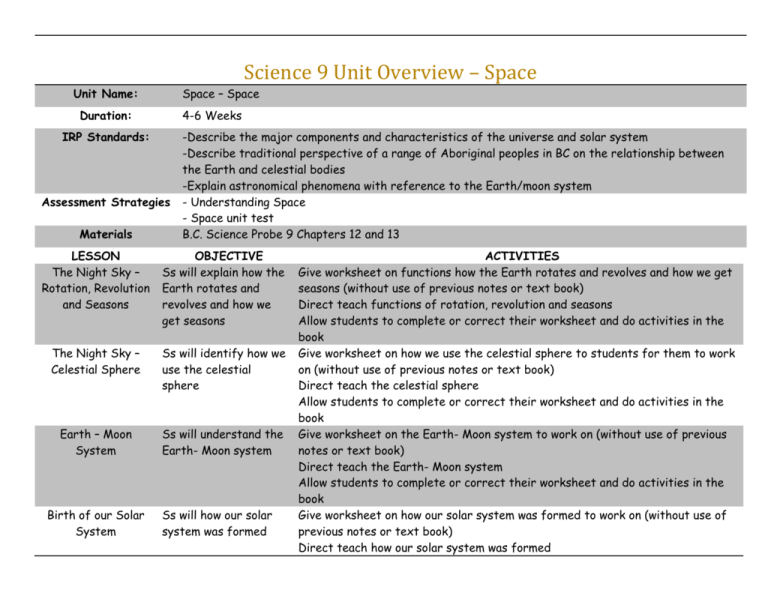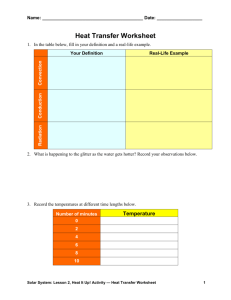Science 9 Unit Overview – Space
advertisement

Science 9 Unit Overview – Space Unit Name: Space – Space Duration: 4-6 Weeks IRP Standards: Assessment Strategies Materials -Describe the major components and characteristics of the universe and solar system -Describe traditional perspective of a range of Aboriginal peoples in BC on the relationship between the Earth and celestial bodies -Explain astronomical phenomena with reference to the Earth/moon system - Understanding Space - Space unit test B.C. Science Probe 9 Chapters 12 and 13 LESSON The Night Sky – Rotation, Revolution and Seasons OBJECTIVE Ss will explain how the Earth rotates and revolves and how we get seasons The Night Sky – Celestial Sphere Ss will identify how we use the celestial sphere Earth – Moon System Ss will understand the Earth- Moon system Birth of our Solar System Ss will how our solar system was formed ACTIVITIES Give worksheet on functions how the Earth rotates and revolves and how we get seasons (without use of previous notes or text book) Direct teach functions of rotation, revolution and seasons Allow students to complete or correct their worksheet and do activities in the book Give worksheet on how we use the celestial sphere to students for them to work on (without use of previous notes or text book) Direct teach the celestial sphere Allow students to complete or correct their worksheet and do activities in the book Give worksheet on the Earth- Moon system to work on (without use of previous notes or text book) Direct teach the Earth- Moon system Allow students to complete or correct their worksheet and do activities in the book Give worksheet on how our solar system was formed to work on (without use of previous notes or text book) Direct teach how our solar system was formed Minor Bodies in our Solar System Ss will name and classify the different minor bodies of our solar system Formation of our Moon Ss will understand how the Moon was formed History of Astronomy The Origin of our Universe Ss will identify different contributions of famous astronomers Ss will explain the Big Bang Theory Birth of Stars Ss will explain how stars are created Solar Anatomy Ss will understand different solar formations Allow students to complete or correct their worksheet and do activities in the book Give worksheet naming and classifying the different minor bodies of our solar system to work on (without use of previous notes or text book) Direct teach naming and classifying the different minor bodies of our solar system Allow students to complete or correct their worksheet and do activities in the book Give worksheet on how the Moon was formed to work on (without use of previous notes or text book) Direct teach how the Moon was formed Allow students to complete or correct their worksheet and do activities in the book Give worksheet on the contributions of famous astronomers to work on (without use of previous notes or text book) Direct teach the contributions of famous astronomers Allow students to complete or correct their worksheet and do activities in the book Give worksheet on the Big Bang Theory to work on (without use of previous notes or text book) Direct teach the Big Bang Theory Allow students to complete or correct their worksheet and do activities in the book Give worksheet how stars are created to work on (without use of previous notes or text book) Direct teach how stars are created Allow students to complete or correct their worksheet and do activities in the book Give worksheet on solar formations to work on (without use of previous notes or text book) Direct teach solar formations Death of Stars Ss will explain how stars die Assignment See Appendix A Space Test Space test Allow students to complete or correct their worksheet and do activities in the book Give worksheet on how stars die to work on (without use of previous notes or text book) Direct teach how stars die Allow students to complete or correct their worksheet and do activities in the book Introduce to the assignment to students Show examples of work from students done in years past Give students up to two or three weeks to work on the assignment in teams of no more than two Note: This assignment is most likely given 1/4 of the way through the above lessons. It designed so that students work on the assignment in conjunction with doing the assignment Space test Appendix A - The Assignment as Posted on the Wikipage WHAT: This unit is about demonstrating the beauty of space. You and a partner of your choice (yes, this can be a partnered project) will collaborate in demonstrating your knowledge from any five 'standards' from D2 or D4 (see the list below) and create a 'piece' of work. If you choose do this by yourself, you can do three. RULES: - You may do a combination of definitions (minimum THREE) based on the things we've learned this unit as a piece of work.- You must demonstrate how you collaborated and not just cooperated. If you cooperate in any way then you will need to do SIX partnered pieces. - You must not use the same idea twice in this project. This means that no two pieces will look or be the same. For example, one can be done on paper, another can be a model, another could be a play etc. If you do two pieces on paper, two different mediums could be used (pencils or paint or something else). If you do two pieces on computer, one can be an animation and another a video - You must have a written explanation of the standard AND how your piece relates to it. This must be done for all pieces. The quality of your written explanation will determine a good portion of your grade as it should teach other students and help them understand this portion of the standard - All pieces should look good, show creativity and be neat Assessments: This assignment most likely will be worth 1.5 times a standard project so please work carefully. Bonus marks will be given for beauty on a) best overall piece and second place b) best group of work (taken from all three-six pieces submitted) and second place Of course the bonus marks are regardless of science and all on creativity and beauty. This is important because people learn and contemplate longer when the work is beautiful. - identify galaxies, star clusters/types, planets, constellations, nebulae according to their distinguishing characteristics - relate mass to different stages in the life cycle of stars - describe theories on the nature of the solar system (e.g., Ptolemy, Copernicus, Kepler) - describe the formation of the solar system (e.g., condensing nebula) and its components (e.g., planets, moons, comets, asteroids, the Sun) and the formation of the universe (e.g., Big Bang) - describe the processes that generate and events that distribute the energy of the Sun and other stars (e.g., nuclear fusion, solar flares and prominences, sun spots, solar wind) - describe the formation of the Earth’s moon, with reference to supporting evidence - describe the significance of Earth’s rotation, revolution, and axis tilt (e.g., seasons, day/night) - describe the celestial sphere in relation to constellations and their locations - explain the apparent motion of constellations, planets, the Sun, the moon, asteroids, and comets - explain and illustrate solar and lunar eclipses



